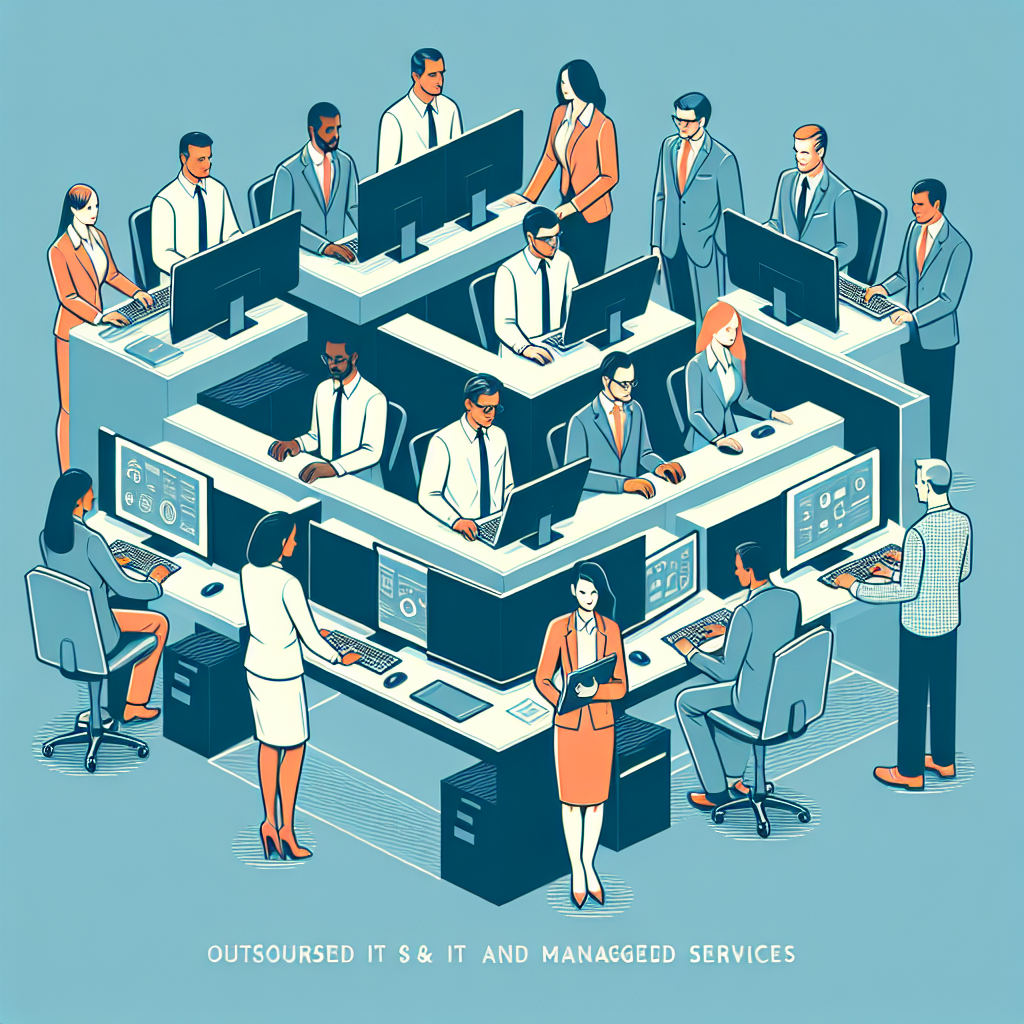Your cart is currently empty!
Tag: Top

Top Reasons to Consider Outsourcing IT with Managed Services
Outsourcing IT with managed services has become an increasingly popular option for businesses of all sizes. By entrusting their IT needs to a third-party provider, companies can focus on their core operations and leave the technical aspects to the experts. Here are some top reasons why businesses should consider outsourcing IT with managed services:1. Cost savings: One of the most significant benefits of outsourcing IT with managed services is cost savings. By outsourcing, businesses can avoid the hefty costs associated with hiring and training an in-house IT team. Managed service providers typically offer flexible pricing plans, allowing businesses to pay only for the services they need.
2. Access to expertise: Managed service providers are staffed with highly skilled and experienced IT professionals. By outsourcing IT, businesses can gain access to a team of experts who specialize in various areas of technology. This expertise can help businesses stay ahead of the curve and implement the latest technologies to improve efficiency and productivity.
3. 24/7 support: IT issues can arise at any time, and having a dedicated team available around the clock to address these issues is crucial for business continuity. Managed service providers offer 24/7 support, ensuring that any IT problems are quickly resolved to minimize downtime and keep operations running smoothly.
4. Proactive monitoring and maintenance: Managed service providers proactively monitor and maintain IT systems to prevent potential issues before they arise. This proactive approach helps businesses avoid costly downtime and ensures that their IT infrastructure is always running at peak performance.
5. Scalability: As businesses grow, their IT needs evolve. Managed service providers offer scalable solutions that can easily accommodate growth and changes in technology requirements. Whether businesses need to add new users, upgrade software, or expand their network, managed service providers can quickly scale their services to meet these needs.
6. Enhanced security: Cybersecurity threats are constantly evolving, and businesses need to stay ahead of these threats to protect their sensitive data. Managed service providers offer robust security solutions to help businesses safeguard their IT systems and data from cyberattacks, viruses, and other security threats.
In conclusion, outsourcing IT with managed services offers numerous benefits for businesses, including cost savings, access to expertise, 24/7 support, proactive monitoring and maintenance, scalability, and enhanced security. By partnering with a reputable managed service provider, businesses can streamline their IT operations, improve efficiency, and focus on their core business goals.

Top Trends in Managed Services: What Businesses Need to Know
Managed services have become an integral part of modern businesses, allowing companies to outsource IT tasks and focus on their core competencies. As technology continues to evolve, so do managed services, with new trends shaping the industry. Here are the top trends in managed services that businesses need to know about:1. Artificial Intelligence and Machine Learning: AI and machine learning are revolutionizing managed services by enabling predictive maintenance, automated troubleshooting, and improved security measures. These technologies can analyze large amounts of data to identify patterns and anomalies, allowing businesses to proactively address issues before they impact operations.
2. Cloud Computing: Cloud computing has become a popular choice for businesses looking to scale their IT infrastructure without the need for costly hardware investments. Managed service providers are increasingly offering cloud services, allowing businesses to access their data and applications from anywhere, at any time.
3. Cybersecurity: With the rise of cyber threats, cybersecurity has become a top priority for businesses of all sizes. Managed service providers are now offering advanced security solutions, such as intrusion detection and prevention, vulnerability assessment, and threat intelligence, to protect businesses from cyber attacks.
4. IoT Management: The Internet of Things (IoT) has transformed the way businesses operate, with connected devices collecting and transmitting data in real-time. Managed service providers are now offering IoT management services to help businesses monitor and manage their IoT devices, ensuring they operate efficiently and securely.
5. Remote Work Solutions: The COVID-19 pandemic has accelerated the shift towards remote work, with businesses relying on managed services to support their remote workforce. Managed service providers are offering solutions such as virtual desktop infrastructure, secure remote access, and collaboration tools to help businesses adapt to the new work environment.
6. Compliance and Regulation: With increasing regulations around data privacy and security, businesses need to ensure they are compliant with industry standards and regulations. Managed service providers are offering compliance management services to help businesses navigate complex regulatory requirements and avoid costly fines.
7. Managed Backup and Disaster Recovery: Data loss can have a devastating impact on businesses, leading to downtime, lost revenue, and damage to reputation. Managed service providers are offering backup and disaster recovery solutions to help businesses protect their data and quickly recover in the event of a disaster.
In conclusion, the managed services industry is constantly evolving to meet the changing needs of businesses. By staying informed about the latest trends and partnering with a reputable managed service provider, businesses can leverage technology to drive innovation, improve efficiency, and stay ahead of the competition.

Top Reasons Why Companies Are Turning to Managed Services
In today’s fast-paced business world, companies are constantly looking for ways to streamline their operations, increase efficiency, and reduce costs. One trend that has been gaining popularity in recent years is the adoption of managed services. Managed services involve outsourcing certain business functions to a third-party provider who is responsible for managing and maintaining those services.There are several reasons why companies are turning to managed services to meet their business needs. Here are some of the top reasons why companies are making the switch:
1. Cost savings: One of the biggest reasons companies are turning to managed services is the cost savings they can achieve. By outsourcing certain functions, companies can reduce the need for in-house staff, equipment, and infrastructure, which can lead to significant cost savings in the long run.
2. Access to expertise: Managed service providers are experts in their respective fields and have the knowledge and experience to handle complex tasks and projects. By partnering with a managed service provider, companies can tap into this expertise and benefit from the latest technologies and best practices.
3. Scalability: Managed services offer companies the flexibility to scale their services up or down based on their changing needs. This scalability allows companies to quickly adapt to market changes and growth opportunities without the need for significant investments in infrastructure or resources.
4. Improved security: Data security and protection are top priorities for companies in today’s digital age. Managed service providers have the expertise and resources to implement robust security measures and protocols to safeguard sensitive information and prevent data breaches.
5. Focus on core business activities: By outsourcing non-core functions to a managed service provider, companies can free up their internal resources to focus on strategic initiatives and core business activities. This allows companies to increase productivity and efficiency while reducing distractions and inefficiencies.
6. Enhanced reliability and performance: Managed service providers offer service level agreements (SLAs) that guarantee a certain level of performance and reliability for the services they provide. This can help companies ensure that their critical business functions are always up and running, minimizing downtime and disruptions.
7. Compliance and regulatory requirements: Many industries have strict compliance and regulatory requirements that companies must adhere to. Managed service providers can help companies navigate these requirements and ensure that they are in compliance with all relevant laws and regulations.
Overall, the adoption of managed services can offer companies a range of benefits, including cost savings, access to expertise, scalability, improved security, and the ability to focus on core business activities. As the business landscape continues to evolve, more companies are likely to turn to managed services to help them stay competitive and agile in an increasingly digital world.

Top Tools and Technologies for Managing IT Infrastructure
In today’s fast-paced and technology-driven world, managing IT infrastructure is crucial for businesses to stay competitive and efficient. With the increasing complexity and scale of IT systems, it’s important to have the right tools and technologies in place to effectively manage and monitor infrastructure.Here are some of the top tools and technologies for managing IT infrastructure:
1. Infrastructure Monitoring Tools: These tools provide real-time monitoring of network, server, and application performance to identify issues and bottlenecks before they impact users. Popular monitoring tools include Nagios, Zabbix, and SolarWinds.
2. Configuration Management Tools: These tools automate the process of configuring and managing servers, ensuring consistency and reducing the risk of human error. Tools like Puppet, Chef, and Ansible help streamline infrastructure management tasks.
3. Virtualization Technologies: Virtualization allows IT teams to create virtual instances of servers, storage, and networks, enabling greater flexibility and scalability. Leading virtualization technologies include VMware, Microsoft Hyper-V, and Citrix XenServer.
4. Cloud Management Platforms: With the increasing adoption of cloud services, cloud management platforms like AWS CloudFormation, Microsoft Azure Resource Manager, and Google Cloud Deployment Manager help organizations manage and automate their cloud infrastructure.
5. Containerization Tools: Containers provide a lightweight and portable way to package and deploy applications, making it easier to manage complex IT environments. Docker, Kubernetes, and OpenShift are popular containerization tools used for managing IT infrastructure.
6. Network Management Tools: Network management tools help IT teams monitor and troubleshoot network performance, security, and compliance. Tools like Cisco Prime Infrastructure, SolarWinds Network Performance Monitor, and ManageEngine OpManager are widely used for network management.
7. Database Management Tools: Managing databases is a critical aspect of IT infrastructure management. Tools like Oracle Enterprise Manager, Microsoft SQL Server Management Studio, and MySQL Workbench help IT teams monitor and optimize database performance.
8. Incident Management Tools: Incident management tools help IT teams track and resolve incidents and outages quickly and efficiently. Tools like ServiceNow, Jira Service Desk, and Zendesk provide a centralized platform for managing IT incidents.
9. Backup and Disaster Recovery Solutions: Data backup and disaster recovery are essential for protecting critical business data and ensuring business continuity. Popular backup and disaster recovery solutions include Veeam Backup & Replication, Commvault, and Acronis Backup.
10. IT Service Management (ITSM) Platforms: ITSM platforms help organizations streamline and automate IT service delivery and support processes. Leading ITSM platforms like ServiceNow, BMC Helix, and Freshservice help organizations manage IT infrastructure efficiently.
In conclusion, having the right tools and technologies for managing IT infrastructure is essential for ensuring the reliability, performance, and security of IT systems. By leveraging these top tools and technologies, businesses can effectively monitor, automate, and optimize their IT infrastructure to support their digital transformation initiatives.

Top Data Backup Solutions for Small Businesses
In today’s digital age, data is one of the most valuable assets for businesses of all sizes. However, small businesses often overlook the importance of data backup and recovery until it’s too late. Data loss can be devastating for a small business, leading to lost revenue, damaged reputation, and even closure. That’s why it’s crucial for small businesses to invest in reliable data backup solutions to protect their valuable information.Here are some of the top data backup solutions for small businesses:
1. Cloud Backup Services: Cloud backup services offer a convenient and cost-effective solution for small businesses to backup their data securely. With cloud backup, data is stored offsite in secure data centers, protecting it from physical disasters such as fires or floods. Cloud backup services also provide automatic backups, so you don’t have to worry about remembering to back up your data regularly.
2. External Hard Drives: External hard drives are a simple and affordable data backup solution for small businesses. You can manually back up your data to an external hard drive on a regular basis, or use software that automatically backs up your data at scheduled intervals. External hard drives are portable and easy to use, making them a popular choice for small businesses with limited IT resources.
3. Network Attached Storage (NAS): NAS devices are another popular data backup solution for small businesses. NAS devices connect to your network and provide a centralized storage solution for backing up data from multiple devices. NAS devices offer features such as RAID (Redundant Array of Independent Disks) for data redundancy and protection against drive failures.
4. Backup Software: Backup software is a crucial component of any data backup strategy. Backup software automates the backup process, making it easy to schedule regular backups and restore data quickly in the event of a data loss. Many backup software solutions offer features such as encryption, compression, and deduplication to optimize storage space and protect sensitive data.
5. Hybrid Backup Solutions: Hybrid backup solutions combine the benefits of on-premises and cloud backup to provide a comprehensive data protection strategy. With hybrid backup, you can backup your data locally to a NAS device or external hard drive, and also replicate your data to the cloud for offsite protection. Hybrid backup solutions offer the flexibility and scalability to meet the data backup needs of small businesses.
In conclusion, data backup is a critical component of a small business’s IT strategy. Investing in reliable data backup solutions can help protect your business from the devastating consequences of data loss. Whether you choose cloud backup services, external hard drives, NAS devices, backup software, or hybrid backup solutions, it’s essential to have a data backup plan in place to safeguard your valuable information. Don’t wait until it’s too late – start backing up your data today!

Top 10 IT Solutions for Streamlining Your Business Operations
In today’s fast-paced business world, it’s essential for companies to stay ahead of the curve when it comes to technology. With the right IT solutions in place, businesses can streamline their operations, increase productivity, and ultimately drive growth. Here are the top 10 IT solutions that can help streamline your business operations:1. Cloud Computing: Cloud computing allows businesses to store and access their data and applications over the internet, eliminating the need for physical servers and hardware. This can greatly reduce costs and improve flexibility and scalability.
2. Business Process Automation: Using software to automate repetitive tasks and workflows can save time and improve efficiency. From email marketing to customer service, there are numerous tools available to streamline business processes.
3. Customer Relationship Management (CRM) Software: CRM software helps businesses manage relationships with customers and track sales and marketing activities. By centralizing customer data, businesses can improve customer service and increase sales.
4. Enterprise Resource Planning (ERP) Systems: ERP systems integrate various business functions, such as finance, inventory, and human resources, into one centralized platform. This can streamline operations and improve communication between departments.
5. Project Management Tools: Project management tools help businesses plan, organize, and track projects and tasks. This can improve collaboration among team members and ensure projects are completed on time and within budget.
6. Cybersecurity Solutions: With the increasing threat of cyber attacks, it’s essential for businesses to invest in cybersecurity solutions to protect their data and systems. This can include firewalls, encryption, and security monitoring tools.
7. Mobile Apps: Mobile apps can help businesses connect with customers and employees on the go. From mobile payment options to employee scheduling tools, there are numerous ways mobile apps can streamline business operations.
8. Data Analytics Tools: Data analytics tools help businesses analyze their data to make informed decisions and identify trends and patterns. This can improve business performance and drive growth.
9. Communication and Collaboration Tools: Communication and collaboration tools, such as video conferencing and instant messaging platforms, help businesses connect with employees and clients regardless of location. This can improve communication and productivity.
10. Internet of Things (IoT) Devices: IoT devices, such as smart sensors and connected devices, can collect and exchange data to improve business operations. From inventory management to predictive maintenance, IoT devices can streamline various aspects of a business.
In conclusion, investing in the right IT solutions can help businesses streamline their operations, improve efficiency, and ultimately drive growth. By staying up to date with the latest technology trends and implementing the right tools, businesses can stay ahead of the competition and achieve success in today’s digital age.

Top Strategies for Providing Exceptional Technical Support to Your Customers
In today’s fast-paced and technology-driven world, providing exceptional technical support to your customers is essential for maintaining customer satisfaction and loyalty. Whether you’re a small startup or a large corporation, having a solid technical support strategy in place can make all the difference in how your customers perceive your brand. Here are some top strategies for providing exceptional technical support to your customers:1. Invest in the right tools and technology: To provide exceptional technical support, you need to have the right tools and technology in place. This includes a robust ticketing system, live chat support, remote desktop access, and a knowledge base for self-service support. Investing in these tools will help streamline your support process and provide quicker resolutions to your customers’ issues.
2. Hire and train knowledgeable support staff: Your technical support team is the face of your company when it comes to resolving customer issues. Hiring and training knowledgeable support staff is crucial for providing exceptional technical support. Make sure your support team has the necessary technical skills and expertise to effectively troubleshoot and resolve customer issues.
3. Offer multiple channels for support: In today’s digital age, customers expect to have multiple channels for support. Whether it’s through phone, email, live chat, or social media, offering multiple channels for support will make it easier for customers to reach out to you with their technical issues. Be responsive and proactive in addressing customer concerns across all channels.
4. Provide proactive support: Instead of waiting for customers to reach out with issues, provide proactive support by monitoring their usage patterns and behavior. By proactively identifying and resolving potential issues before they escalate, you can demonstrate your commitment to customer satisfaction and build trust with your customers.
5. Continuously gather customer feedback: Customer feedback is invaluable when it comes to improving your technical support process. Continuously gather feedback from customers through surveys, reviews, and follow-up calls to understand their pain points and areas for improvement. Use this feedback to make data-driven decisions and enhance your technical support strategy.
6. Personalize the support experience: Personalizing the support experience can go a long way in building strong customer relationships. Address customers by their name, acknowledge their previous interactions with your support team, and tailor your responses to their specific needs and preferences. A personalized support experience shows customers that you value their business and are committed to providing exceptional service.
7. Implement a knowledge base: A knowledge base is a valuable resource for both customers and support staff. By creating a comprehensive knowledge base with FAQs, troubleshooting guides, and step-by-step tutorials, you empower customers to find solutions to common technical issues on their own. This not only reduces the volume of support tickets but also helps customers feel empowered and in control of their technical problems.
In conclusion, providing exceptional technical support to your customers requires a combination of the right tools, knowledgeable staff, proactive support, and a customer-centric approach. By implementing these top strategies, you can enhance the overall support experience for your customers and build long-lasting relationships that drive customer loyalty and satisfaction.

The Top Trends in Managed Services: What to Expect in 2021 and Beyond
Managed services have become increasingly popular in recent years as businesses look for ways to streamline their IT operations and reduce costs. With the rapid pace of technological advancements, it’s important for businesses to stay on top of the latest trends in managed services in order to remain competitive and efficient. Here are some of the top trends to expect in 2021 and beyond:1. Increased focus on cybersecurity: With the rise of cyber threats and data breaches, businesses are placing a greater emphasis on cybersecurity in their managed services offerings. Managed service providers are now offering more robust security solutions, such as advanced threat detection and response, encryption, and identity and access management, to help protect their clients’ sensitive data.
2. Cloud migration and optimization: As more businesses move their operations to the cloud, managed service providers are helping them with the migration process and optimizing their cloud environments for improved performance and cost savings. In 2021, we can expect to see even greater emphasis on cloud migration and optimization services, as businesses continue to embrace the benefits of cloud computing.
3. Automation and artificial intelligence: Automation and artificial intelligence are becoming increasingly important in managed services, as businesses look for ways to streamline their operations and improve efficiency. Managed service providers are leveraging automation and AI technologies to automate routine tasks, monitor and manage IT infrastructure, and provide predictive analytics for better decision-making.
4. Remote work support: With the shift to remote work due to the COVID-19 pandemic, businesses are looking for managed service providers that can support their remote workforce with secure access to company resources and collaboration tools. Managed service providers are offering remote work solutions, such as virtual private networks (VPNs), secure remote desktops, and cloud-based communication tools, to help businesses adapt to the new normal.
5. Compliance and governance: As regulations around data privacy and security continue to evolve, businesses are looking for managed service providers that can help them navigate complex compliance requirements and ensure that their IT operations are in line with industry standards. Managed service providers are offering compliance and governance services, such as regulatory audits, risk assessments, and policy development, to help businesses stay compliant and avoid costly fines.
Overall, the future of managed services looks bright, with businesses turning to managed service providers for a wide range of IT solutions to help them stay competitive and secure in an increasingly digital world. By staying on top of the latest trends in managed services, businesses can ensure that they have the tools and support they need to succeed in 2021 and beyond.

Top Cybersecurity Threats and How to Combat Them
In today’s digital age, cybersecurity threats are becoming more prevalent and sophisticated. From ransomware attacks to phishing scams, it’s crucial for individuals and organizations to be vigilant and proactive in protecting their sensitive information. Here are some of the top cybersecurity threats and how to combat them:1. Ransomware attacks: Ransomware is a type of malware that encrypts a victim’s files and demands payment in exchange for the decryption key. These attacks can be devastating for businesses, causing data loss and financial damage. To combat ransomware, it’s essential to regularly back up your data and ensure that your systems are up to date with the latest security patches. Additionally, educating employees about the dangers of clicking on suspicious links or downloading attachments from unknown sources can help prevent ransomware attacks.
2. Phishing scams: Phishing scams are fraudulent attempts to obtain sensitive information, such as passwords or credit card numbers, by posing as a trustworthy entity in an email or message. These scams can be difficult to detect, as they often appear legitimate. To combat phishing scams, it’s important to be cautious when opening emails or messages from unknown sources. Look for any spelling or grammatical errors, and avoid clicking on links or providing personal information unless you are certain of the sender’s identity.
3. Insider threats: Insider threats occur when employees or contractors misuse their access to sensitive information for malicious purposes. This can include stealing data, installing malware, or leaking confidential information. To combat insider threats, organizations should implement strict access controls and monitor employee activity to detect any unusual behavior. Additionally, conducting regular security training and awareness programs can help educate employees about the importance of safeguarding sensitive information.
4. DDoS attacks: Distributed Denial of Service (DDoS) attacks are a type of cyberattack that overwhelms a website or network with a flood of traffic, causing it to become unavailable to legitimate users. To combat DDoS attacks, organizations can use DDoS mitigation services to protect their networks and servers from being overwhelmed. Additionally, implementing strong firewalls and regularly monitoring network traffic can help detect and mitigate DDoS attacks before they cause significant damage.
In conclusion, cybersecurity threats are a serious concern for individuals and organizations alike. By staying informed about the latest threats and implementing robust security measures, you can help protect your sensitive information from falling into the wrong hands. Remember to regularly update your systems, educate employees about cybersecurity best practices, and stay vigilant against potential threats. By taking proactive steps to combat cybersecurity threats, you can better safeguard your data and protect your digital assets.

Top Trends in IT Infrastructure Management for 2021 and Beyond
As technology continues to evolve at a rapid pace, IT infrastructure management is becoming increasingly complex and challenging. In order to stay ahead of the curve, businesses need to stay informed about the latest trends in IT infrastructure management. Here are some of the top trends to look out for in 2021 and beyond:1. Hybrid and Multi-Cloud Environments: With the rise of cloud computing, many organizations are now using a combination of public and private clouds to host their applications and data. Managing multiple cloud environments requires a different approach than traditional on-premises infrastructure, and IT teams will need to adapt to this new reality.
2. Edge Computing: As the Internet of Things (IoT) continues to grow, more data is being generated at the edge of the network. Edge computing allows organizations to process and analyze this data closer to where it is being generated, reducing latency and improving performance. IT infrastructure management will need to evolve to support this distributed computing model.
3. Automation and DevOps: Automation and DevOps practices are becoming increasingly important in IT infrastructure management. By automating routine tasks and integrating development and operations teams, organizations can speed up deployment times and improve overall efficiency. IT teams will need to embrace automation tools and practices to stay competitive in today’s fast-paced environment.
4. Security and Compliance: With the increasing threat of cyber attacks and data breaches, security and compliance are top priorities for IT infrastructure management. Organizations will need to invest in robust security measures, such as encryption, access controls, and monitoring tools, to protect their data and infrastructure. Compliance with regulations such as GDPR and HIPAA will also be crucial for organizations in 2021 and beyond.
5. AI and Machine Learning: Artificial intelligence and machine learning are increasingly being used to optimize IT infrastructure management. These technologies can help organizations predict and prevent outages, optimize resource allocation, and improve overall performance. IT teams will need to develop their skills in AI and machine learning to take full advantage of these tools.
6. Containerization and Microservices: Containerization and microservices are changing the way applications are deployed and managed. By breaking down applications into smaller, modular components, organizations can achieve greater flexibility and scalability. IT infrastructure management will need to adapt to support this new paradigm, including container orchestration tools like Kubernetes.
In conclusion, IT infrastructure management is constantly evolving, and organizations need to stay abreast of the latest trends to remain competitive. By embracing hybrid and multi-cloud environments, edge computing, automation, security, AI, containerization, and microservices, organizations can build a resilient and agile IT infrastructure that can support their business goals in 2021 and beyond.
